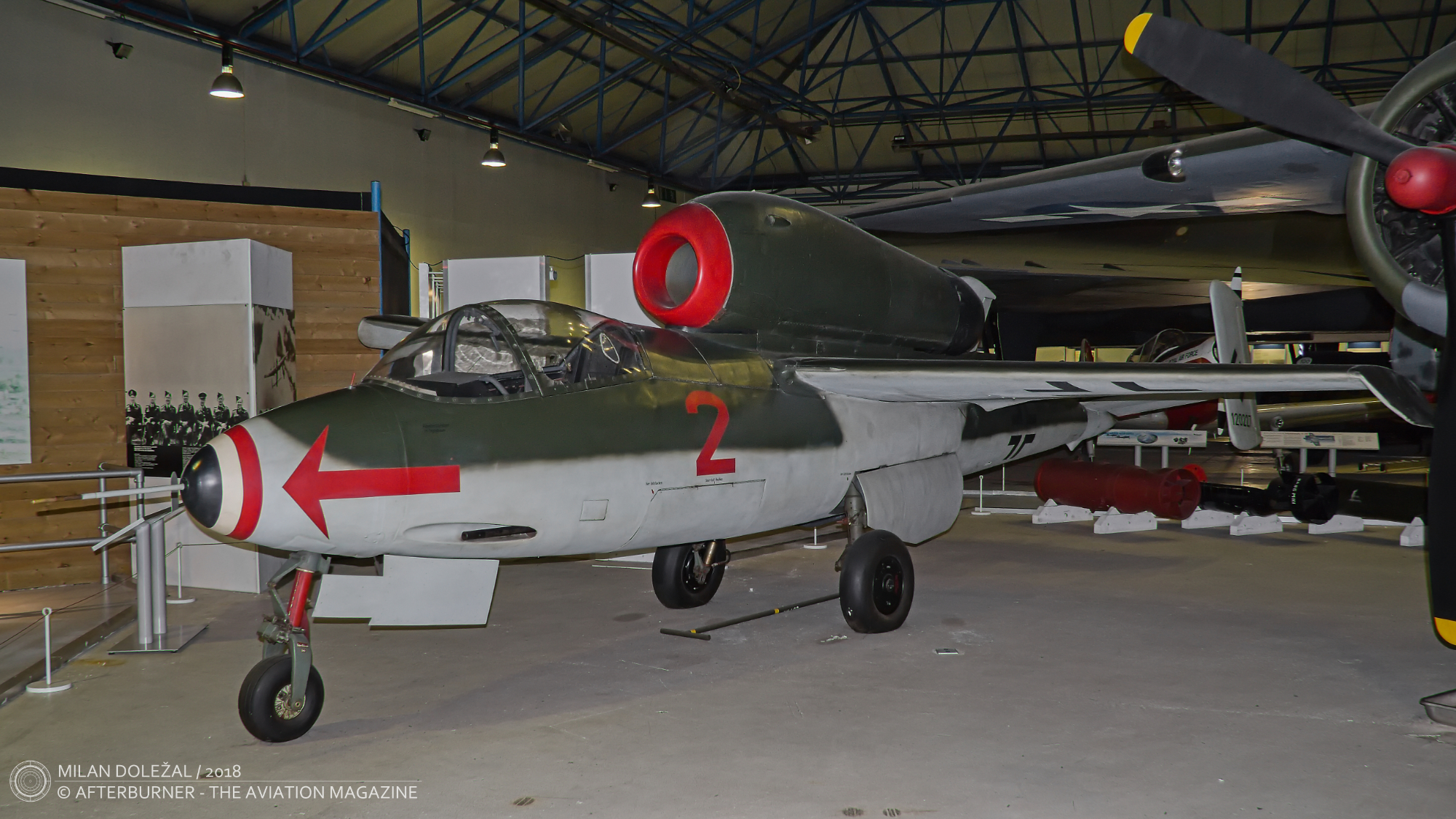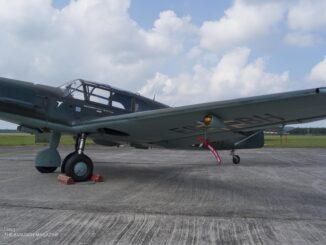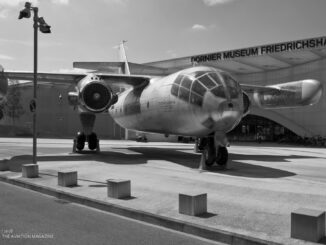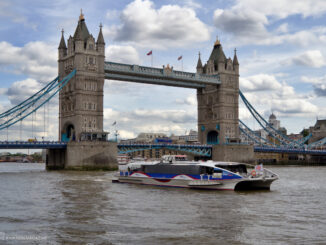 Heinkel He 162 A-2 Volksjäger (c/n 120227, formerly VN679 of the RAF), exhibited at the Royal Air Force Museum in Hendon, London, July 2018.
Heinkel He 162 A-2 Volksjäger (c/n 120227, formerly VN679 of the RAF), exhibited at the Royal Air Force Museum in Hendon, London, July 2018.
By early 1944, the German aviation authorities slowly began realising that they were falling behind the Allied aviation development. During wartime, both the United States Army Air Forces and the Royal Air Force were successively introducing into service new types of aircraft. Their design incorporated the latest technical innovations and experiences gained during the first years of the war. At the same time, the Luftwaffe was still operating the aeroplanes developed in the late 1930s.
Although significantly modernized, Messerschmitt Bf 109 (first flight in May of 1935) and Focke-Wulf Fw 190 (first flight in June of 1939) were the backbone of the German fighter aviation. Nevertheless, in 1944 they hardly managed to keep up with the latest Allied fighters but turned out to be ineffective against the newest versions of Boeing B-17 Flying Fortress and Consolidated B-24 Liberator bomber aircraft. Weapons the German fighters were equipped with, slowly started to be too weak against heavy, four-engine bombers. At the same time, they were neither armed nor fast enough to withstand more and more powerful defensive armament of the Allied aircraft. What´s more, the effective range of the USAAF and the RAF fighters was successively extended.
As a result, German air strategy was about to collapse. The Luftwaffe was losing more and more pilots and aircraft – step by step ceasing to be able to maintain air superiority over Germany.
Regrettably for Germany, development of new fighter aircraft for Luftwaffe was lagging behind. The delay was caused by combination of several factors. First of all, the Nazi leaders expected it had to be a short and victorious war, so initially it seemed there was no reason to think about next generation of combat aeroplanes. In addition, German resources were heavily exploited, and not sufficient for all country´s war projects, then the industry was rotten by political wrangling and usual mischief-making supported by particular aviation manufacturers.
One of the most-promising German fighters, that was expected to regain the air superiority for the Luftwaffe, was Messerschmitt Me 262 Schwalbe, the first operational jet fighter in the world. Although the aircraft made its first flight already in April of 1941, it was still not ready for service at the beginning of 1944. The Me 262 development was delayed not only due to technological difficulties, but mainly by requirements issued personally from Hitler and Göring. Long story short, the Me 262 was designed as fighter interceptor, then re-designed to be a light bomber / ground support aircraft, and finally became the interceptor again.
Eventually, the Me 262 was introduced into operational service in mid-1944, despite still having several technical issues and being equipped with engines that have been wearing off too quickly. In addition, production capabilities of Schwalbe were too low compared to Luftwaffe needs.
As a consequence, the Luftwaffe authorities began to look for a simple, cheap and effective fighter aircraft that could be used against formations of the Allied bombers. Design and performance principles of the new fighter were stated in Jägernotprogramm (English: Emergency Fighter Programme), issued by Reichsluftfahrtministerium (English: Ministry of Aviation) on 3rd June of 1944. The idea of creating the simple fighter was personally supported by Reichsmarschall Hermann Göring.
Contest for the fighter was opened in August of 1944 and officially named Volksjäger (English: People´s Fighter). The new aeroplane had to be easy to produce, made mostly of wood, with minimum of metal parts, powered by simple jet engine and, finally, easy to operate, even for not experienced pilots. What Volkswagen (English: People´s Car) had to be for German automotive industry, the new Volksjäger had to be for the fighter aviation.
The competition was won by Heinkel and his Spatz (English: sparrow) design. It was a small (9.05 m length, 7.2m wingspan) aircraft, powered by a single, top-mounted BMW 003 turbojet engine. The aeroplane was made of wood with minimum use of light alloys. It was designed for easy production and minimum maintenance – in case of any serious issues disposal of the aeroplane was preferred over repairs.
The Heinkel´s aircraft was quickly approved for serial production under official designation He 162. However, the aeroplane had several commonly used nicknames, including the aforementioned Spatz, then Salamander (taken from code-name of its wings development programme) and, certainly, Volksjäger.
On 6th December 1944, just three months after the competition, the He 162 performed its maiden flight. In January of the next year, Volksjäger was introduced into active service.
Although it had to be one of the ´wonder-weapons´ (Wunderwaffe) giving Germany the chance to win the World War II, the He 162 turned out to be just another German failure – and another programme that led to waste of forces and means.
The operational service of the He 162 shortly exposed its shortcomings. Light and small construction did not allow the fighter to carry enough fuel, the engine endurance was too short and – most of all – Volksjäger was very difficult to fly, even for an experienced pilot. There was no way the He 162 could be flown by any rookies after a short glider training, as it was initially expected.
Eventually, the aircraft spent most of the last months of the war in operational testing at Erprobungskommando 162 (Test Unit 162). For the first time, the He 162 was used in real combat in mid-April of 1945 and at that time it could not have any influence on the course of the war. In addition, it still was not ready for service – thirteen aircraft and ten pilots were lost in a short time, mostly due to technical failures, with just two aircraft shot down.
Although there were approximately 350 aircraft manufactured until the end of the war, only 120 of them were sent to Luftwaffe combat unit before the end of the war. Their combat history was very brief and inefficient. Most probably, the He 162 did not shot down any Allied aircraft – usual assumption, based on German records, is just two air victories, however none of them was officially confirmed.
After the war, the Allied forces captured a significant number of the He 162 fighters. Among them there were approximately 200 aircraft completed but not delivered to combat units, as well as further 600 examples of Salamander still on their production lines, in different stage of completion. It allowed the British and American pilots to perform several tests of Volksjäger that led to conclusion that the He 162 was generally a well-designed aeroplane. Its main disadvantages were low quality materials used for its construction and rapid, careless production.
The aircraft featured within our Photo of the Week series was initially operated by JG 1 (Jagdgeschwader 1 Oesau – the 1st Fighter Wing). It was captured by the Allies and then taken on strength with the RAF as VN679. In 1947 it was transferred to Aircraft Historical Branch and then handed over to the RAF Museum for exhibition purposes.



